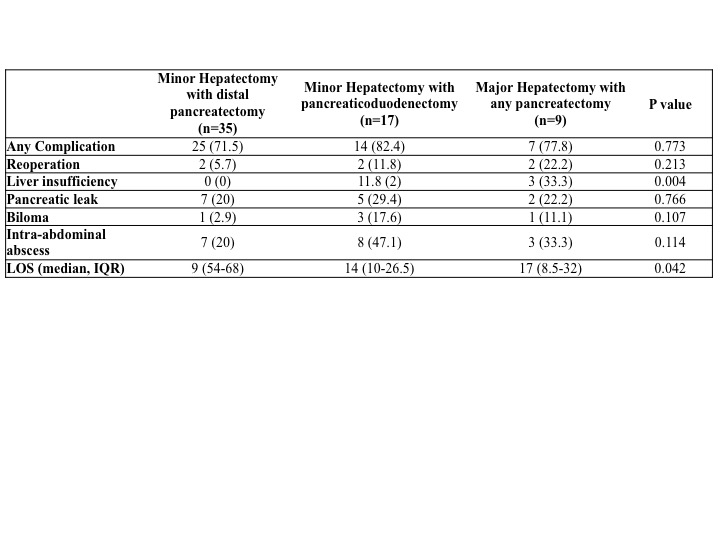T. B. Tran1, J. N. Leal1, M. M. Dua1, B. C. Visser1, J. A. Norton1, G. A. Poultsides1 1Stanford University,Surgery,Stanford, CA, USA
Introduction: Simultaneous resection of both the liver and the pancreas remains controversial due to the high morbidity and questionable oncologic benefit. The purpose of this study is to evaluate the short-term morbidity and mortality after combined resection of the liver and pancreas, as well as to determine whether or not these aggressive operations are associated with long-term survival.
Methods: Consecutive patients who underwent synchronous hepatectomy and pancreatectomy (SHP) at a single instution were retrospectively evaluated. Extent of liver resection was categorized into major hepatectomy (defined as lobectomy or trisectionectomy) and minor hepatectomy (less than 3 liver segments). Preoperative patient features, perioperative outcomes, and long-term survival following synchronous hepatectomy and pancreatectomy (SHP) were evaluated.
Results: From 2005 to 2014, 61 patients underwent SHP. Diagnoses include 34 pancreatic neuroendocrine tumors (PNET), 6 sarcomas, 3 cholangiocarcinomas, 3 adrenocortical carcinomas, 3 cystic pancreatic neoplasms, 2 renal cell carcinomas, 2 colon cancers, 2 recurrent gastric cancers, 2 gastrointestinal stromal tumors, 2 peritoneal mesotheliomas, 1 appendiceal cancer, and 1 ovarian cancer. Patients were further categorized into 3 groups based on the extent of SHP (Table). There were no differences in patient demographics, comorbidities, ASA status, estimated blood loss, need for blood transfusion, 30 or 90-day mortality. Furthermore, the incidence of major complications was similar between the three groups, except for liver insufficiency (defined as peak postoperative bilirubin of 7 or more), which affected one-third of patients who underwent major hepatectomy with any pancreatectomy (p=0.004). Length of stay correlated with extent of SHP (p=0.042). Patients with PNET had more favorable prognosis compared to all other malignant histologies combined (5-year overall survival 47% vs. 26%; p=0.002).
Conclusion: Combined hepatectomy with pancreatectomy is a technically challenging operation. In carefully selected patients, combined hepatectomy and pancreatectomy can be associated with long-term survival.
